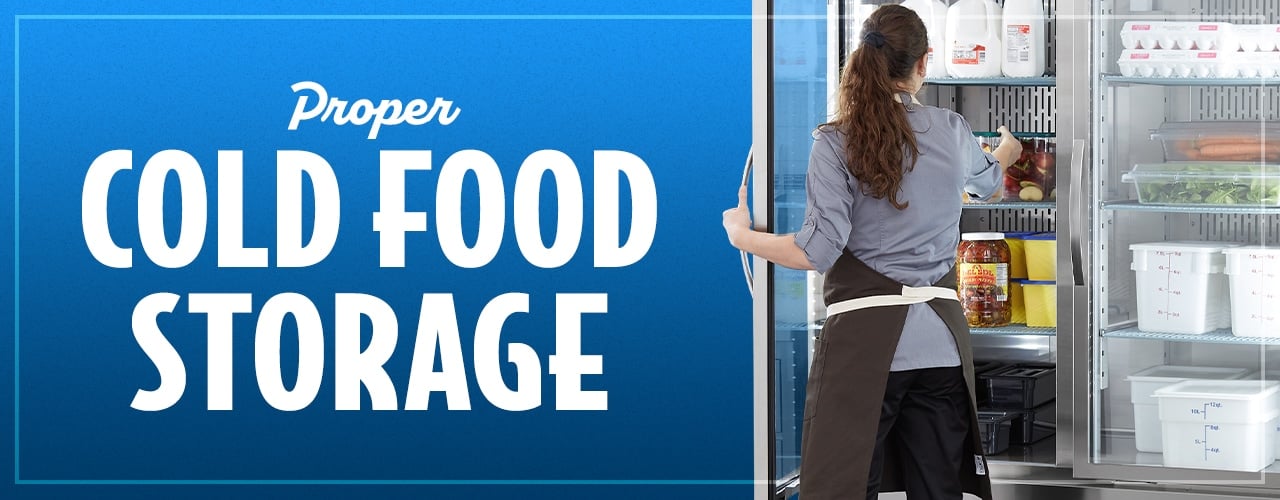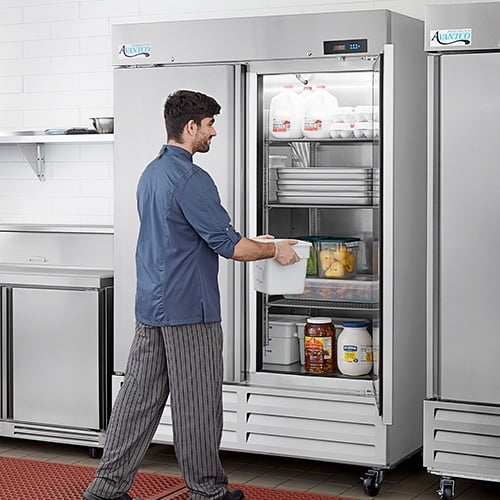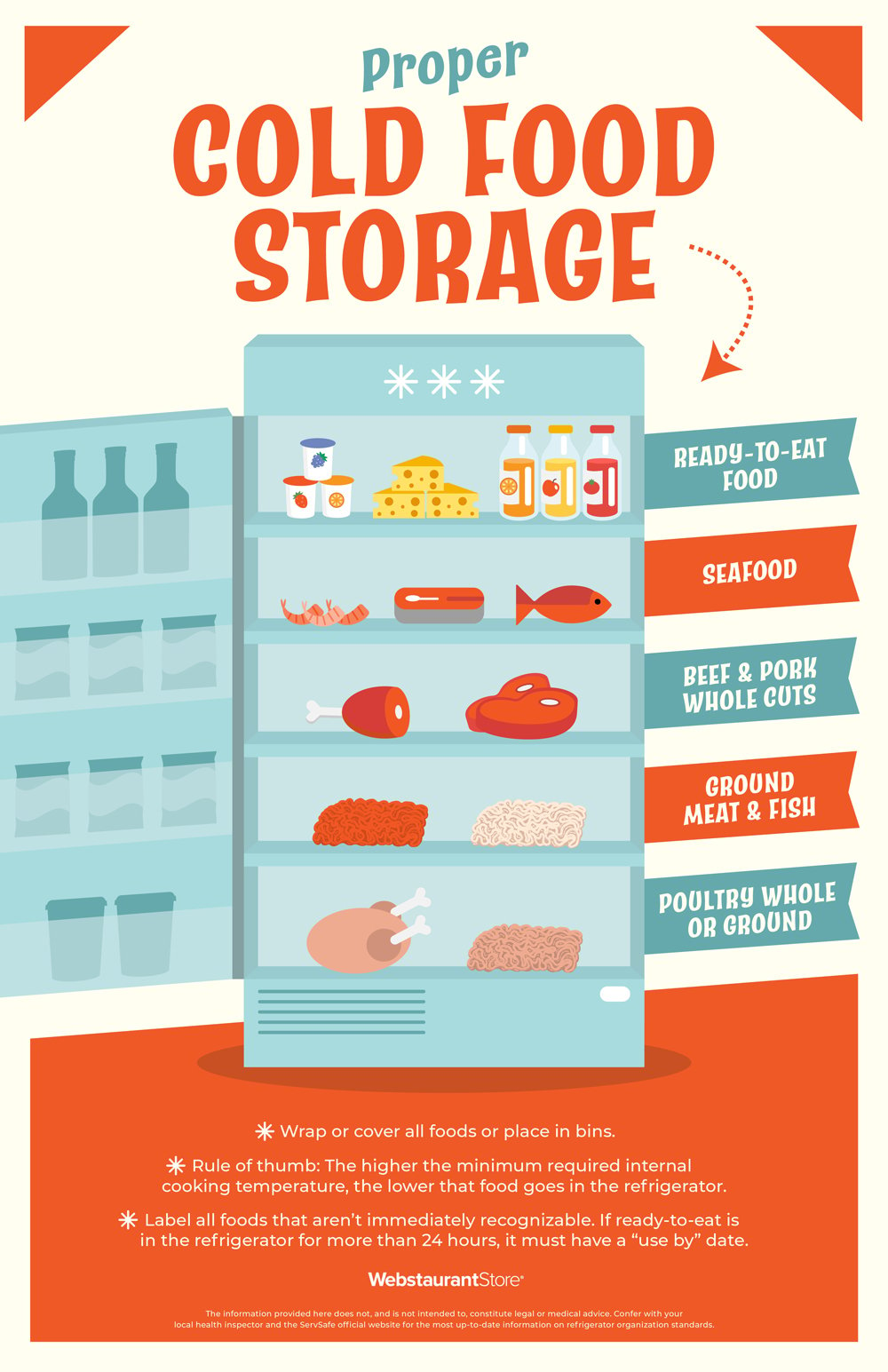
Cold food storage is a key part of any commercial kitchen and essential for maintaining food safety and quality. By storing perishable items at the correct temperature and in the correct order, you can prevent the growth of harmful bacteria and spoilage of food. We'll provide you with an overview of the best practices for cold food storage, including recommended storage methods and tips for organizing a refrigerator or freezer. We have also included two printable cold food storage charts for you to used in your establishment.
What Temperature Should a Refrigerator Be?
When it comes to refrigeration, it is crucial to ensure that the refrigerator is set at the appropriate temperature to maintain the quality and safety of perishable items. The ideal temperature for a refrigerator is 40 degrees Fahrenheit or below, while the freezer should be set at 0 degrees Fahrenheit or below. These temperatures help to keep food fresh and out of the danger zone where bacteria can grow rapidly. By maintaining the correct refrigerator and freezer temperatures, commercial establishments can uphold food safety standards and prevent the risk of foodborne illnesses.
Fridge Storage Order

One crucial aspect of cold food storage is the organization of items within the refrigerator. Following a specific fridge storage order helps prevent cross-contamination and ensures optimal freshness. By storing ready-to-eat foods on the top shelves, raw meats and seafood on the middle shelves, and poultry on the bottom shelf, you can minimize the risk of harmful bacteria spreading and maintain the integrity of your ingredients.
Avoid potential health code violations by using this comprehensive guide to organize your cold food storage correctly:
- Top Shelf: Ready-to-eat foods, such as cooked meats, deli items, and leftovers, should be stored on the top shelves of your commercial refrigerator. These foods are typically already cooked and require little to no further preparation, making them susceptible to cross-contamination if placed below raw food items.
- Second Shelf: Whole cuts of raw seafood, including fish, shellfish, and sushi ingredients, should be stored below ready-to-eat foods. This helps prevent any potential drips or leaks from contaminating the ready-to-eat items.
- Third Shelf: Whole cuts of raw meat, such as beef, pork, and lamb, should be stored below whole raw seafood. You may also store eggs that will be served immediately on this shelf.
- Fourth Shelf: Ground meat and fish, including injected, marinated, and tenderized meats. Eggs that will be hot-held should also go on this shelf.
- Bottom Shelf: Whole or ground poultry, such as chicken and turkey, should be stored on the bottom shelf. Poultry has a higher risk of harboring harmful bacteria, so it's important to keep it below other foods.
Fridge Organization Tips

Incorporating these refrigerator organization tips into your cold food storage practices can help reduce the risk of foodborne illnesses and food spoilage:
- Use Food Labeling Stickers: Properly labeling food items is essential for maintaining a well-organized fridge. Food labeling stickers help identify the contents of each container or package, along with the date it was prepared or stored. This practice ensures that you can easily keep track of your inventory and avoid confusion or waste. Make sure to use stickers that are specifically designed for refrigerator use, as they are resistant to moisture and won't leave any residue when removed.
- Implement the "First In, First Out" Method: The "First In, First Out" (FIFO) method is a crucial technique for maintaining food safety and minimizing waste. It involves arranging food items in the fridge based on their expiration dates, with the oldest items placed in front and the newest items towards the back. By following this method, you ensure that older products are used or discarded before they expire, reducing the risk of spoilage and maintaining the quality of your inventory.
- Use Color-Coded Bins: Color-coding your food bins is a simple yet effective way to organize different categories of food in your commercial fridge. Assign specific colors to different types of food, such as meat, dairy, fruits, vegetables, and condiments. This visual cue allows your staff to quickly identify and locate items, reducing the time spent searching through the fridge. Color-coded bins also help prevent cross-contamination by keeping different food groups separate.
- Clean Your Refrigerator Regularly: Perform a deep clean of your refrigerator every 3-4 months. You'll want to unplug your unit and discard any expired food. Wipe and disinfect the inside of the refrigerator before cleaning the condenser and coils. This will ensure that food isn't spoiling in storage and that your unit is operating at peak performance.
For a visual representation of how you should stock your unit, check out this restaurant food safety fridge storage guide:

Click here to print out this useful guide and leave it in your walk-in fridge to ensure your employees are using the proper procedure when organizing your unit.
Download PDFCold Food Storage Chart
In addition to implementing proper refrigerator organization, it's important to know how long you can store cold foods before they become unsafe for consumption. Use this chart as a reminder of how long items can be safely kept before they must be discarded to meet the necessary standards for food safety and quality.
| Food Item | Refrigerator (40°F) | Freezer (0°F) |
|---|---|---|
| Bacon | 1 week | 1 month |
| Beverages | 3 weeks unopened, 7-10 days opened | 8-12 months |
| Cheese - hard (Swiss) | 3-4 weeks | 6 months |
| Cheese - soft (brie) | 1 week | 6 months |
| Chicken, egg, macaroni, and tuna salad | 3-4 days | Do not freeze |
| Cottage cheese | 1 week | Do not freeze |
| Country ham | 1 week | 1 month |
| Dough - cookie | Use by date | 2 months |
| Dough - tube cans of rolls, biscuits, and pizza dough | Use by date | Do not freeze |
| Egg substitutes - opened | 3 days | Do not freeze |
| Egg substitutes - unopened | 3 days | 1 year |
| Eggs - fresh in shell | 3-5 weeks | Do not freeze |
| Eggs - hard cooked | 1 week | Do not freeze |
| Fish - fatty (salmon) | 1-3 days | 2-3 months |
| Fish - lean (cod) | 1-3 days | 6 months |
| Fresh crab and lobster meat | 2-4 days | 2-4 months |
| Ground meats - raw | 1-2 days | 3-4 months |
| Ham - fully cooked, slices | 3-5 days | 1-2 months |
| Ham - fully cooked, whole | 1 week | 1-2 months |
| Hot dogs - opened | 1 week | 1-2 months |
| Hot dogs - unopened | 2 weeks | 1-2 months |
| Luncheon meats - opened | 3-5 days | 1-2 months |
| Luncheon meats - unopened | 2 weeks | 1-2 months |
| Margarine | 4-5 months | 12 months |
| Mayonnaise - opened | 2 months | Do not freeze |
| Milk | 1 week | 3 months |
| Poultry - cooked | 3-4 days | 2-6 months |
| Poultry - fresh, chicken or turkey | 1-2 days | 6 months |
| Prepared leftovers | 3-4 days | 2-3 months |
| Sausage - raw | 1-2 days | 1-2 months |
| Sausage - cooked | 1 week | 1-2 months |
| Sausage - purchased frozen | 3-4 days (after cooking) | 1-2 months (from date of purchase) |
| Shucked clams, mussels, and oysters | 3-10 days | 3-4 months |
| Soups and stews | 3-4 days | 2-6 months |
| Steaks, chops, and roasts - raw | 3-5 days | 4-12 months |
Click here to print out our cold food storage chart.
Download PDFYour refrigerator is a major hub in your kitchen. Maintaining an organized fridge and freezer can help you reduce food waste, avoid health code violations, and enforce food safety in your business. Print out our cold storage resources to help train your staff and keep your kitchen running efficiently.





